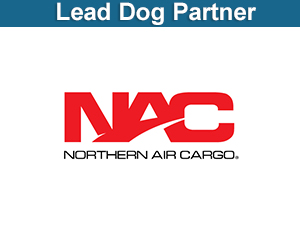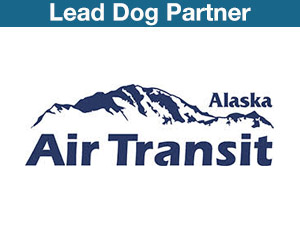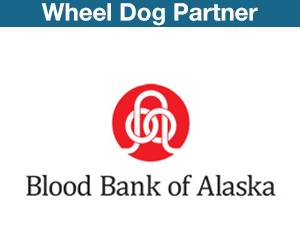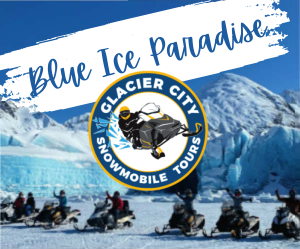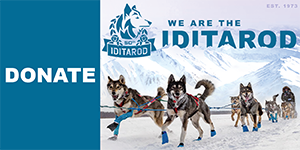by Donald Bowers, Jr.
Quick Overview
There is only one thing to say about this leg—bleak, flat, and deadly monotonous. Locals say the actual distance is under 50 miles, but it always seems like a hundred. There is not so much as a shrub on this stretch, most of which is over the sea ice of Norton Bay. Plan on five to nine hours for the crossing, more if the wind is blowing hard.
The trail runs almost due north from Shaktoolik, overland across very low rolling terrain for about nine miles to Reindeer Cove, then across the ice for five miles to Island Point, then back onto the ice immediately for the last 45 miles to Koyuk. There are no hills.
The trail is also the main snowmachine trail to Koyuk and is well used. However, winds can wipe it smooth in hours. It is well marked with Iditarod trail stakes, spruce boughs, or both. The trail can range from a groomed speedway to rough ice to drifted snow to glare ice. The wind is usually blowing, and almost always right in your face. Days with less than 20 or 30 mph breezes are uncommon. The wind can blow at hurricane velocity out here and ground blizzards can reduce visibility to zero in minutes. You MUST check the weather carefully before heading out. If you get caught in a storm on the ice, you will be in very serious trouble.
Another problem is that some dogs are put off by the white expanse and won’t go or will try to turn back. Every year teams stall here; some drivers are able to get their teams going after a rest, and some can get their leaders to follow another team across. Some have to scratch. This is where a “coast leader” is invaluable; these are leaders used to running in this environment and who aren’t fazed by winds or wide-open spaces.
Detailed Description
You’ll leave Shaktoolik via the slough behind the village, paralleling a long, eight-foot-high snow fence on your right (north). The snow fence is about the only thing that keeps Shaktoolik from being completely buried in drifts during the winter. The trail goes through The Gate, the main opening in the fence; there will probably be many snowmachine tracks here, so watch the markers.
Once past the fence, you’ll be running across gently rolling and often windswept tundra for eight or nine miles. Some of the villagers have reindeer herds which wander in this area; you might see some (they look just like caribou) know when you come to the shore of Reindeer Cove: everything ahead will be completely flat.
During the day you should see Island Point about five miles ahead across the cove; it’s a hundred-foot rock at the end of a low-lying peninsula jutting out from the mainland on the right. At night you will probably begin to see the red light on the FAA radio beacon at Koyuk, which is on a hill behind the village and is visible for almost the entire trip. (You may become intensely frustrated because you never seem to get any closer to the light.)
Once on the ice, the trail will be dead level and virtually straight. After five miles you’ll come abeam Island Point; the trail may cross over the peninsula or may stay out on the ice. There is a dilapidated shelter cabin at the foot of Island Point; more than a few mushers have had to hole up here to wait out storms. It doesn’t offer much in the way of facilities, but it’s in the lee of Island Point and is the only place to get out of the wind until Koyuk.
After Island Point, you’re well and truly on the bounding main. The water underneath you isn’t very deep (maybe 20 feet at the most) but it’s definitely salt water. You may see some pressure ridges but little else along the way. There may be cracks in the ice, some of which can be several inches wide. These are normal and shouldn’t cause you any concern. You will probably also hear the ice cracking under or around you; also normal, if a bit unnerving.
Stories about the ice cracking off and drifting mushers and their teams out to sea are probably a bit overdone. (At least it hasn’t happened in recent memory.) The important thing is to stay on the trail_go marker to marker if you have to, and stop and wait out the weather if you get lost. It is entirely possible to get turned around and headed out to open water, which is usually at least 10 to 20 miles to the southwest.
From Island Point to Koyuk is about a 340-degree compass heading if all else fails. The whole way you should be able to see the ridges and mountains surrounding Norton Bay eventually begin to see the buildings (or lights) of Koyuk still have at least ten miles to go. Just bear with it and eventually you’ll pull into the checkpoint, just back from the beach. There may or may not be water available here (but there’s always plenty of snow to melt). The race usually has a building rented for staff and mushers to rest in, but it may be a couple of blocks from the dogs. You’re only 171 miles from Nome.
On a historical note, the original Iditarod Trail didn’t go to Koyuk. It went by Shaktoolik and continued south of Elim to Golovin, skirting much closer to the open water than the race trail does today. During the 1925 Serum Run, Leonhard Seppala drove his dogs (behind his leader, Togo) nonstop from Nome toward Unalakleet and Kaltag, thinking he was going to pick up the serum somewhere on the Yukon River.
He unexpectedly met Henry Ivanoff carrying the vaccine on the ice just offshore of Shaktoolik. Seppala loaded up the serum and immediately started back without even resting his dogs. He went almost directly across the mouth of Norton Bay to Golovin, where he passed the life-saving package to Gunnar Kaasen and his legendary leader, Balto (who, by the way, actually belonged to Seppala).
Seppala’s route from Shaktoolik to Golovin was extremely dangerous and difficult, made worse by high winds and 40-below temperatures and the ever- present threat of open water and moving ice. Seppala was already widely regarded as the territory’s best musher, and his part of the serum run was certainly the hardest of any of the 20 mushers who participated. Togo worked so hard on the Serum Run he injured himself and never raced again.









